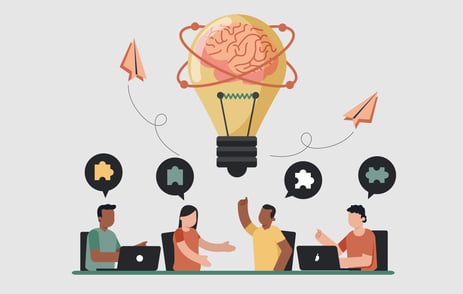The use of taxonomies in organizing and classifying information is essential for associations and organizations. Traditional taxonomies have been the go-to method for structuring content and making it more manageable. However, they come with their own set of challenges.
Designing a taxonomy requires specialized skills and critical thinking, and maintaining it is an ongoing process as professional fields evolve. Multiple correct representations of a taxonomy can lead to debates and disagreements. Furthermore, the manual effort required to classify content within a taxonomy and tag it appropriately can be significant.
What is a traditional taxonomy?
A traditional taxonomy is a hierarchical classification system that organizes information into categories based on their attributes and is characterized by rigorous categorization rules, mutually exclusive classification, and exhaustive granularity. In the context of an association, a traditional taxonomy can be used to categorize and organize various aspects of the organization. Here's an example of a traditional taxonomy for an association's content categories:
- Content Category: Research
- Subcategory: Whitepapers
- Subcategory: Case Studies
- Subcategory: Research Reports
- Content Category: Events
- Subcategory: Webinars
- Subcategory: Conferences
- Subcategory: Workshops
- Content Category: Education
- Subcategory: Online Courses
- Subcategory: Certification Programs
- Subcategory: Training Materials
- Content Category: News and Updates
- Subcategory: Press Releases
- Subcategory: Newsletters
- Subcategory: Blog Posts
In this example, the taxonomy starts with the broadest category, which is the Content Category. Each subsequent level represents different types of content within that category.
While traditional taxonomies can be effective for organizing content within an association, their rigidity and hierarchy poses challenges including difficulty adapting to new content types, complex and time-consuming management, overlapping content, and poor scalability.
How can AI revolutionize association taxonomies?
AI tools can suggest taxonomy structures, maintain taxonomies as content evolves, and automatically tag content within the taxonomy. This means that the manual maintenance and tagging of taxonomies can be minimized with AI assistance. However, there is still significant overhead associated with agreeing on a taxonomy and living within its confines.
One alternative to traditional taxonomies is the use of AI-generated tag taxonomies. Using Natural Language Processing (NLP) engines and large language models, organizations can automatically and dynamically classify and categorize content, without the need for predefined taxonomies. NLP engines understand and expertly tag content, creating a dynamic set of semantic understanding. This automated tagging can be used to auto-generate a taxonomy or complement a structured taxonomy with additional insights.
Benefits to Using AI-Generated Tag Taxonomies
The use of AI-generated tag taxonomies provides several immediate benefits that underpin better member service, including:
Increased Efficiency: With the help of AI, organizations can automatically generate and update taxonomies based on the evolving content and needs of the organization. This automation streamlines content management and organization and reduces the time and effort required to create, maintain, and update taxonomies.
Consistency in Categorization and Tagging: AI systems learn from the content, developing a better understanding of the relationships and connections between different pieces of content. This leads to more accurate and consistent tagging, improving the overall organization and discoverability of information.
Improved Scalability: As new content is created or acquired, AI systems can automatically analyze and categorize it, ensuring the taxonomy remains up to date and relevant. This scalability is particularly beneficial for large organizations with vast amounts of content to manage.
Flexibility: Unlike traditional taxonomies, which can be rigid and difficult to modify, AI-generated taxonomies can be easily updated and customized to suit the unique requirements of an organization.
Potential Challenges to Using AI-based Taxonomies
While the benefits are undeniable, implementation of AI-based taxonomies may present drawbacks and can be complex and resource-intensive, requiring investment in technology, infrastructure, and personnel.
Relying on AI systems for managing and organizing content creates a dependence on these systems, making organizations more vulnerable to potential issues with the AI, such as technical failures, inaccuracies, or biases.
There is also risk associated with the loss of human expertise in content organization and classification. While AI is constantly improving, human experts possess unique skills and knowledge that may not be fully captured by AI systems. Organizations must these address ethical concerns related to privacy, data security, and potential biases in the AI algorithms.
Real World Use Cases for AI-Generated Taxonomies
AI-generated tag taxonomies help organizations find information, group related content, and compare ideas. AI's deep understanding of content goes beyond the one-dimensional tags in a taxonomy, allowing for more effective categorization and search.
The use of AI has profound implications for various industries. In healthcare, AI-generated taxonomies can help categorize and organize medical research, improving patient care. In the legal field, they can help manage and analyze large volumes of case documents and legal precedents, enhancing legal research. In education, AI-generated taxonomies can assist in organizing and classifying courses and learning materials, benefiting students. In science and research, they can facilitate the organization of research papers and data sets, enabling researchers to build upon existing knowledge more easily.
AI Will Improve Content Organization
Taxonomies play a crucial role in organizing and classifying content. However, traditional taxonomies face substantial challenges in their design and maintenance. AI-generated taxonomies offer an alternative that streamlines content organization and retrieval. As AI continues to advance, organizations should consider the benefits of AI-generated taxonomies and plan to integrate them into their operations.
If you want to learn more about how AI can revolutionize association management, download our free book "Ascend: Unlocking the Power of AI for Associations." It provides in-depth insights into the potential of AI in association management and how to leverage its power for success. Don't miss out on this opportunity to stay ahead of the curve and unlock the full potential of AI for your association's future. Download "Ascend" today!

Tags:
Artificial Intelligence
August 10, 2023


